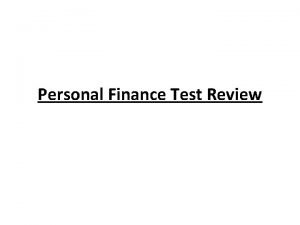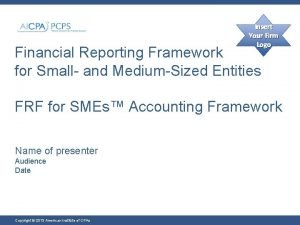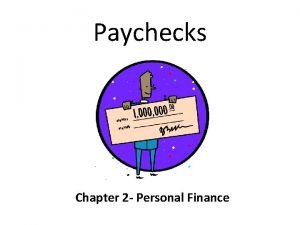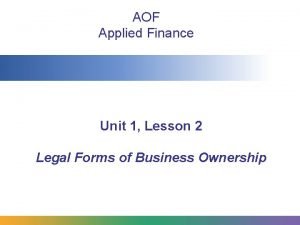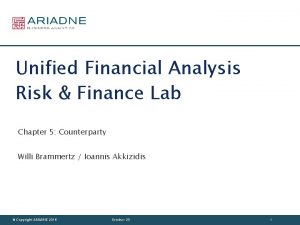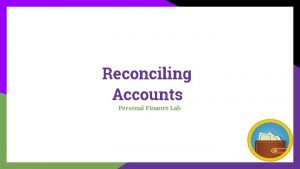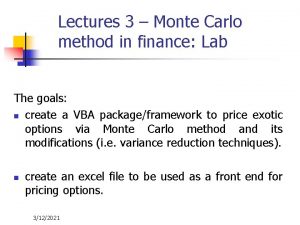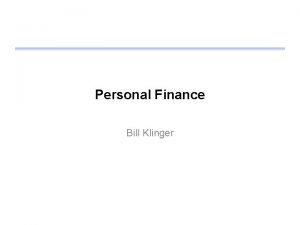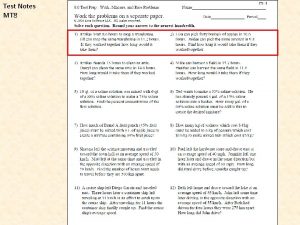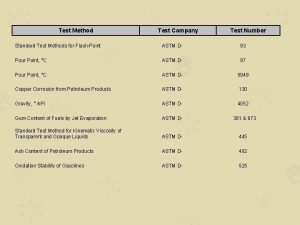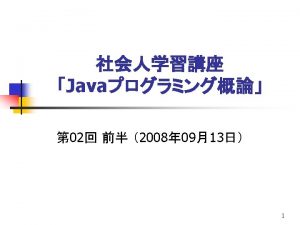Personal Finance Notes Test 1 I Personal Financial




























- Slides: 28

Personal Finance Notes Test #1

• I. Personal Financial Planning is arranging to spend, save and invest your money wisely, so you are able to live comfortably, have financial security , and achieve your personal financial goals • A. Goal setting is the foundation of personal financial planning • • 1. There are 3 types of financial goals a. Short Term Goals are goals that you would like to achieve within 3 months b. Intermediate Term Goals are goals that you would like to accomplish within 3 months to a year c. Long Term Goals are goals that you would like to accomplish over a year or longer • 2. Unfortunately, most people never reach their financial goals because, because they fail to plan and have no financial goals

• B. Before planning for the future we must understand the concept of money; • Money is something that is used for trading, saving, lending, and investing • 1. Money (currency) itself has no real value unless people accept is as something of value • 2. Money in the U. S. is fiat money, meaning the government has deemed it money or legal tender • 3. In the past, people used shells, stones, corn, etc. for money • 4. Modern society uses coins, currency, checks and debit cards for money • 5. Goods and services are directly exchanged using money

• 6. Functions of Money - Money has 3 basic functions • a. It’s a medium of exchange meaning it’s used to purchase goods/services in the global marketplace • b. It’s a standard of value it’s used to measure the value of goods/services • c. It’s a store of value meaning it holds it’s value and can be stored or saved

• 7. Properties of money For money to function in an economy, it should possess the following characteristics: • a. It should be divisible meaning it can be divided into smaller units (eg. a dollar bill can de divided into 4 quarters, etc. ) • b. It’s Usable meaning you can take it anywhere • c. It’s Stable meaning money should have stable value; the stability of money is important to an economy; and the federal government takes measures to keep prices stable to avoid inflation (high prices) or deflation (low prices)

• 8. In today’s global economy each country’s currency has a value that is different from those of other countries • a. A country’s currency’s value is established, in the Foreign Exchange Market (International Currency Market) • b. And global currencies are bought and sold in these foreign exchange markets

• c. When currency values are not set by Foreign Exchange Markets, they are set at fixed rates by their governments • d. The value of one currency in comparison to another currency is called the exchange rate (eg. One U. S. Dollar is worth $13. 35 in Mexican Peso’s) • e. Exchange rates change from day to day, and from country to country

• f. The amount a country’s currency is worth depends on the number of other countries that want to buy their products; If demand for a countries goods and services increase the value of their currency will increase (eg. If demand for California Wine increases in the global marketplace, the value of the dollar will increase in the global marketplace)

• g. When the value of a country’s currency goes up in comparison to another country’s currency, it is said to appreciate in value, and when it goes down, the currency depreciates in value • h. Currency exchange rates affect everyone, whether your shopping online for goods from another country or just buying products that were imported from another country

• I. Currency has 2 classifications: Hard Currency or Soft Currency • 1. Hard Currency is any globally traded currency that is considered stable and highly liquid • Criteria for a currency to be classified as a hard currency is: • * The currency must come from a politically and economically stable country • *The currency has a long term history of the stability of it’s purchasing power • U. S. Dollar British Pound Sterling • European Euro Japanese Yen • Swiss Franc Canadian Dollar • Australian Dollar

• J. Soft Currency (weak currency) is any global currency that is expected to fluctuate erratically or depreciate against other currencies • 1. The currencies of most undeveloped countries are soft currencies • 2. These currencies fluctuate according to the countries political or economic status • 3. These currencies are not preferred for international trade • 4. An example of a soft currency would be the Zimbabwean Dollar •

• II. One major component that affects one’s money is the economy • A. The goals of an economy are economic growth, stable prices and full employment • 1. When a country reaches these goals, businesses, consumers and workers have confidence in the economy

• B. To measure these economic goals the government uses statistical data called economic indicators: • 1. Gross Domestic Product GDP • a. It’s the total dollar value of all goods/services produced in a country within a specific time period • 2. Consumer Price Index CPI • a. Is used to measure the costs of living (meaning it measures the changes in prices of goods/services monthly); this measure indicates is used to indicate inflation, deflation or stable prices

• 3. Unemployment rate is a percentage of the total workforce of people actively seeking employment who are currently unemployed • a. The rate that is acceptable as an economic goal for the U. S. is about 5 percent • b. A low unemployment rate is good for the country as a whole

• C. The money you earn from your chosen occupation or other sources is called Earned Income • 1. Types of Earned Income • a. wages- paid by the hour (eg. $20. 00 per hour) • b. salary- you receive a set amount of payments (eg. $70, 000 per year) • c. Commission – amount of money one earns based upon the level of sales he/she has obtained

• 2. Gross Income-is the total amount of earned income from your wages/salaries before payroll deductions • 3. Net Income- is the total amount of one’s earned income after payroll deductions are deducted (Take Home Pay) • 4. Discretionary Income-money you have left after paying your essentials, such as bills, clothing, transportation costs, etc. • 5. Payroll Deductions- are money subtracted from your gross income; the biggest deduction for most people are payroll taxes

• D. Payroll Taxes- money that is deducted from your Earned Gross Income • 1. Federal Income Taxes-fee paid to the federal government to help support federal government programs; this money is collected by the employer each pay period and paid to the IRS (Internal Revenue Service) • 2. State Income Taxes- fee paid to the state where you reside, to pay for state government programs; this money is collected by the employer each pay period and paid to the Treasury Department in the state you reside in

• 3. Social Security Tax (FICA)- is a federal program that collects taxes from most employees to fund federal programs for the elderly, the blind and low income families/individuals • 4. Medicare – are taxes collected from most employees to fund medical benefits for individuals 65 years of age or over

• E. Taxes are classified as: • 1. Progressive Tax Rate are taxes that impose a higher tax rate on those with higher incomes • 2. Regressive Tax Rate are taxes that impose a higher tax with lower incomes • 3. Proportional Tax Rate imposes the same tax rate on all regardless of income • a. The U. S. has a Progressive Tax Rate • b. The Progressive Income Tax is used as income redistribution, meaning that the taxes paid by those earning higher incomes is used to pay for social welfare programs such as benefits for the elderly and retired, the sick or invalid, dependent survivors, single mothers, unemployed, work injured and low income families

• F. What is taxed in the U. S. • 1. Personal Income Tax- your income • 2. Sales Tax-goods/services you purchase • 3. Property Tax-real estate • 4. Wealth Tax- estate and gift taxes (estate taxes are taxes on property one receives after someone’s death); gift taxes are (taxes on money or property that you give someone during your lifetime, it’s taxed on the basis of its value) • 5. Excise Taxes- are taxes on certain items such as air fare, gasoline, alcohol, tobacco products and phone service

• II. The first step in your personal financial plan is choosing an occupation (how you earn your living) • A. One can have a career or one can have a job • 1. A Career-is a commitment to work in a field you find interesting and fulfilling; a job is work you do mainly to earn money • 2. Your choice of career will affect the money you make, the people you meet, and how much spare time you have • 3. Having a college education does not guarantee that you will meet your financial goals, however, acquiring more education increases your potential earning power (the amount of money you earn over time)

• C. Besides earning an Income, many employees receive non-cash compensation which are called Benefits • 1. Benefits include the following • a. Health Insurance • b. Life Insurance • c. Paid Vacation • d. Pension (retirement plan) • 3. Companies are not required by law to offer or to pay for employee benefits

• III. Glass Ceiling invisible barrier that prevents minorities and women from getting high level executive jobs in Corporate America • A. Although the media prints that more and more women are in the executive suite, it is very misleading: • 1. More and more women and are bumping into the glass ceiling • 2. The overall global labor remains sharply segregated by sex • 3. Women and minorities are concentrated into certain jobs, mostly staff and support jobs that offer little opportunity for getting to the top

• 4. The highest ranking women and minorities in Corporate America are in non-operating areas such as Human Resources, Public Relations, etc. • 5. The majority of women and minorities have historically been locked out of jobs in the “business mainstream” that lead to executive level positions

• 6. According to studies by Korn/Ferry International, an Executive Recruiting firm the biggest barrier is the “Old-Boy Network”, which means that the male corporate leaders tend to select people that are very much like them • 7. One study found that female executives managed less people, had less freedom to hire and fire, and had less direct control of the company’s assets than their male counterparts

• 8. Globally, women make up 3. 9% of Chief Executive Positions, 8. 5% of Operations Positions(management), 17. 5% of Financial Strategy Roles, and 18. 9% of Shared Services (Human Resources, IT, etc. ) • 9. Studies also found that African Americans, Hispanics and Asians earn 21% less than their white counterparts in the same job

• B. How to break the glass ceiling • 1. Women and minorities must be better than their competition for promotions • 2. Look at your company’s philosophy- if there are no women or minorities in executive positions this is a bad sign • 3. Don’t waste your time- look for a company that values diversity • 4. If you have a lot invested stay and fight- unequal pay and consideration for promotions is considered discrimination under the civil rights act

 Personal finance notes
Personal finance notes The basic rule of a risk-to-return relationship is that …
The basic rule of a risk-to-return relationship is that … Principles of business and finance
Principles of business and finance Chapter 4 review personal finance
Chapter 4 review personal finance Chapter 1 post test personal finance
Chapter 1 post test personal finance Foundations in personal finance chapter 1 summary answers
Foundations in personal finance chapter 1 summary answers Personal finance test 1
Personal finance test 1 Pilbeam k. finance and financial markets
Pilbeam k. finance and financial markets Finance and financial markets keith pilbeam
Finance and financial markets keith pilbeam Neton
Neton Cube wisc
Cube wisc Financial engineering notes
Financial engineering notes Sample notes to financial statements for small entities
Sample notes to financial statements for small entities Financial markets and institutions ppt
Financial markets and institutions ppt Chapter 2 personal finance
Chapter 2 personal finance Personal finance gcse
Personal finance gcse Mypersonalfinancelab
Mypersonalfinancelab Btec business level 3 unit 3 personal and business finance
Btec business level 3 unit 3 personal and business finance Personalfinancelab
Personalfinancelab Personal finance unit 1 lesson 5
Personal finance unit 1 lesson 5 Personal finance lab
Personal finance lab Stages of financial life cycle
Stages of financial life cycle Personal finance lab
Personal finance lab Chapter 8 personal finance
Chapter 8 personal finance Personal finance bell ringers
Personal finance bell ringers Personal finance assignment
Personal finance assignment Personal finance lab
Personal finance lab Introduction to personal finance
Introduction to personal finance Chapter 8 personal finance
Chapter 8 personal finance






